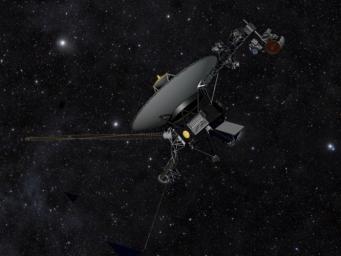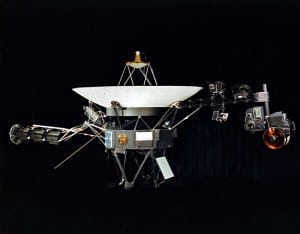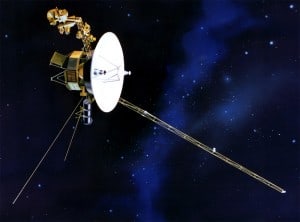
 Emerging into a region where no spacecraft has gone before, NASA’s Voyager 1 appears to have left our solar system and entered interstellar space, says a University of Maryland (UMD)-led team of researchers.
Emerging into a region where no spacecraft has gone before, NASA’s Voyager 1 appears to have left our solar system and entered interstellar space, says a University of Maryland (UMD)-led team of researchers.
Carrying Earthly greetings on a gold plated phonograph record and still-operational scientific instruments, Voyager 1 has traveled farther from Earth than any other human-made object. And now, these researchers say, it has begun the first exploration of our galaxy beyond the Sun’s influence.
“It’s a somewhat controversial view, but we think Voyager has finally left the solar system, and is truly beginning its travels through the Milky Way,” says UMD research scientist Marc Swisdak, lead author of a new paper published online this week in The Astrophysical Journal Letters [dx.doi.org/10.1088/2041-8205/774/1/L8]. Swisdak and fellow plasma physicists James F. Drake, also of UMD, and Merav Opher of Boston University have constructed a model of the outer edge of the solar system that fits recent observations, both expected and unexpected.
Their model indicates Voyager 1 actually entered interstellar space a little more than a year ago,  a finding directly counter to recent papers by NASA and other scientists suggesting the spacecraft was still in a fuzzily-defined transition zone between the Sun’s sphere of influence and the rest of the galaxy.
a finding directly counter to recent papers by NASA and other scientists suggesting the spacecraft was still in a fuzzily-defined transition zone between the Sun’s sphere of influence and the rest of the galaxy.
At issue is what the boundary-crossing should look like to Earth-bound observers 11 billion miles away. The Sun’s envelope, known as the heliosphere, is relatively well-understood as the region of space dominated by the magnetic field and charged particles emanating from our star. The heliopause transition zone is both of unknown structure and location. According to conventional wisdom, we’ll know we’ve passed through this mysterious boundary when we stop seeing solar particles and start seeing galactic particles, and we also detect a change in the prevailing direction of the local magnetic field.
NASA scientists recently reported that last summer, after eight years of travel through the  outermost layer of the heliosphere, Voyager 1 recorded “multiple crossings of a boundary unlike anything previously observed.” Successive dips in, and subsequent recovery of, solar particle counts caught researchers’ attention. The dips in solar particle counts corresponded with abrupt increases in galactic electrons and protons. Within a month, solar particle counts disappeared, and only galactic particle counts remained. Yet Voyager 1 observed no change in the direction of the magnetic field.
outermost layer of the heliosphere, Voyager 1 recorded “multiple crossings of a boundary unlike anything previously observed.” Successive dips in, and subsequent recovery of, solar particle counts caught researchers’ attention. The dips in solar particle counts corresponded with abrupt increases in galactic electrons and protons. Within a month, solar particle counts disappeared, and only galactic particle counts remained. Yet Voyager 1 observed no change in the direction of the magnetic field.
To explain this unexpected observation, many scientists theorize that Voyager 1 has entered a “heliosheath depletion region,” but that the probe is still within the confines of the heliosphere. Swisdak and colleagues, who are not part of the Voyager 1 mission science teams, say there is another explanation.
Now in the 36th year after their 1977 launches, the twin Voyager 1 and 2 spacecraft continue exploring where nothing from Earth has flown before. Their primary mission was the exploration of Jupiter and Saturn. After making a string of discoveries there—such as active volcanoes on Jupiter’s moon Io and intricacies of Saturn’s rings—the mission was extended. Voyager 2 went on to explore Uranus and Neptune, and is still the only spacecraft to have visited those outer planets. The current mission for both spacecraft is to explore the outermost edge of the Sun’s domain and beyond. Both Voyagers are capable of returning scientific data from a full range of instruments, with adequate electrical power and attitude control propellant to keep operating until 2020. Voyager 2 is expected to enter interstellar space a few years after its twin.
Where to next? Voyager 1 is headed in the general direction of the bright star Aldebaran, 68 light years (about 400 trillion miles) away in the constellation Taurus the Bull. At its present speed—39,600 mph relative to the Sun—this interstellar trip might take a few years. Bon voyage, Voyager!
http://www.ask.com/wiki/Voyager_1#Future_of_the_probe


Be the first to comment